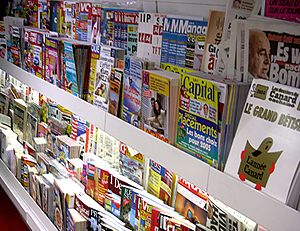
The gang over at Futurismic finally addressed the elephant in the room as applies to the future of short fiction publishing: Is patronage the only way short fiction will survive? This is the main question I've been wrestling with in my own sci-fi magazine 2.0 concept, because it's become pretty apparent that people just won't pay for short stories in the traditional, buy a magazine site unseen and hope what's in it is good sort of way. It's especially true online, where nobody wants to pay for anything not developed by 37signals.
(For those that don't recall the specifics of Magazine 2.0, the idea is this: Rather than query editors for publication, authors query readers directly. They synopsize a story, post the synopsis online, and list a price for which they are willing to publish it. The readership can donate in whatever increments they like until to a set query deadline, and if the price is met, the story is "unlocked" and published. The zealous fans will do most of the bidding, and thus will pay the freight for the majority who refuse to spend money on content. The 90-9-1 rule is thusly observed and monetized.)
Now, the Futurismic folks don't distinguish between celebrity endorsement and outright underwriting, as both rely on a patron to either pay for the content outright so others can enjoy for free, or for the patron to endorse a product so the fanboys will support it as a show of fealty to their fandom crush. In both cases, the content is a supported charity, not a product. This is what Elizabeth Bear calls the "public radio guilt model" and lots of hallowed institutions (public radio, for example) and a few sci-fi magazines are coping on this system. And Bear would know about online publishing, what with her cofounding involvement in Shadow Unit.
Thus we arrive at the glaring hole in my Magazine 2.0 idea -- audience size. As io9 pointed out a while back, the main reason Baen's Universe online magazine is shutting down is that it couldn't grow its audience fast enough to ween itself off of the fiscal teat of its associated fan club membership dues. It was dependent on a specific type of patronage and when that patronage faltered, the magazine was doomed. You must cast your income net to a diversified group of sources so as not to die when when one of supporters stops supporting.
My magazine 2.0 concept can't work before an audience is built, because there is no money in the bank to publish stories on spec as a means of building an audience. Old-fashioned loss leader publishing startup principles won't work here. Magazine 2.0 presupposes an audience who will look at synopses and bid on stories, but it needs stories in order to build that audience.
The answer, I believe, is distributed patronage. I don't want just one John Scalzi using his powers to save Strange Horizons, I want fifty or a hundred John Scalzis bolstering a couple dozen magazines every month. (In this case, Scalzi may be a bad example, as he is a sufficiently bankable author that he only works on commission these days, rather than on spec; most authors are not so lucky.)
Specifically, when Author X submits a story synopsis to Magazine 2.0, it generates a code snippet for a Donate Now button that Author X can publish on his Web site. Thus, Author X's audience becomes Magazine 2.0's audience, even if only for a brief while. Meanwhile, Blogger Y wants a story from Author X on his blog, so he signs up as a Magazine 2.0 Reprinter, and thus gets the right to reprint Author X's story on his blog as well. At the same time, Blogger Y gets his own code snippet to promote donations to unlock Author X's story. (Or, Blogger Y could just pay the unlock cost himself to get the story immediately.) Thus, Blogger Y's audience becomes Magazine 2.0's audience, even if only temporarily. Any Web site that publishes a donation widget that contributes to publication earns simultaneous reprint rights. If you want exclusive online publishing rights (or, more precisely, exclusive except for Magazine 2.0's own copy), you'll have to pay the whole freight yourself.
As to why A-list authors like Scalzi would play this game: Publicity. As Cory Doctorow repeatedly points out, anonymity is the greatest enemy to author success (which is why Doctorow gives away so many loss-leader free ebooks of his stuff). Magazine 2.0 casts the audience net as wide as possible, meaning Scalzi could make his commission rate just as easily under Magazine 2.0, but theoretically be seen by more people as the donate widget spreads to multiple venues. Moreover, for a select list of authors, Magazine 2.0 could be adapted to solicit for commissioned work, rather than spec work. (Scalzi would write the story only after and unless the donation cost was met, not before.)
Magazine 2.0 is thus a meta-magazine, one that houses all the stories it has unlocked for perpetual online consumption and reprint. It is also a platform for enabling other online venues to acquire short fiction (or, conceivably, any) content, and one that co-opts the audience of each venue and contributor as an ever-shifting, distributed donor base.
The launch obstacle thus becomes publicizing and enlisting the use of the platform by authors and venues, but that's a much less steep hill to climb than bootstrapping a magazine audience. Essentially, magazine 2.0 is a crowdsourced marketplace for authors to sell their spec content, and a method for audiences and publishers to acquire said content. Crazy, but I think it can work.
![Reblog this post [with Zemanta]](http://img.zemanta.com/reblog_e.png?x-id=8b78740d-a5c2-41d1-a3e2-8f7a2bc2fe78)
No comments:
Post a Comment